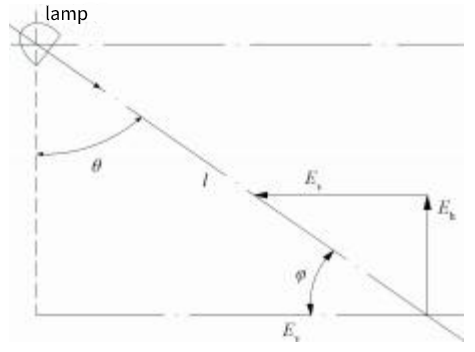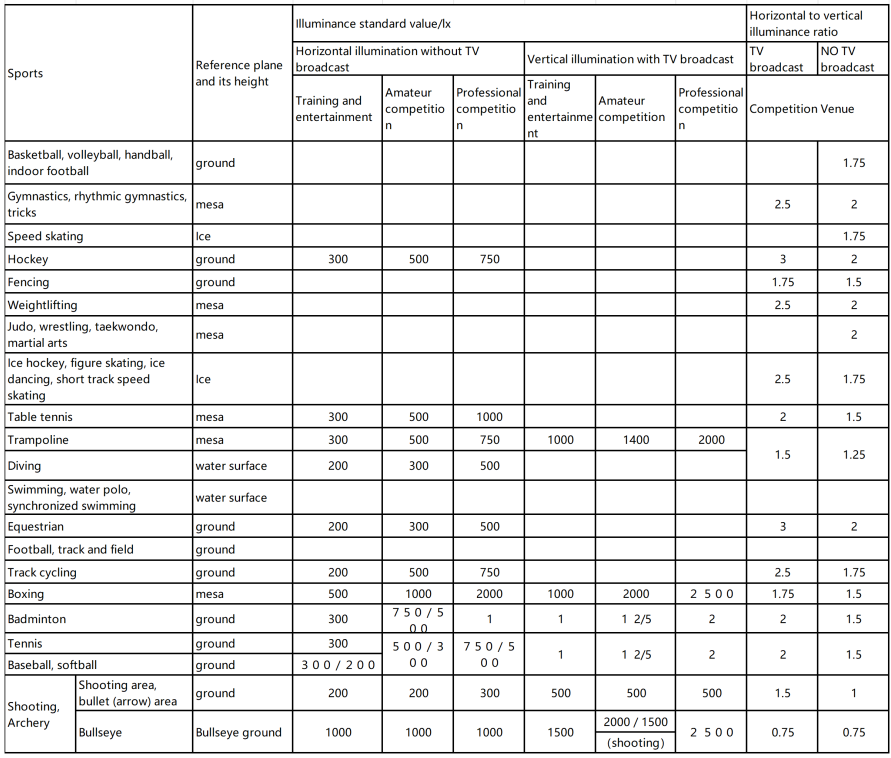Sports Complex Lighting Vertical Illumination

Directory:
1. The Importance of Vertical Illumination in Sports Complex Lighting
2. Vertical Illumination Design Standards
3. Managing the Ratio of Horizontal to Vertical Illuminance
4. Recommended Lighting Design Standards for Sports Complex
Sports can be categorized in various ways, with venues differing in size and the types of sports ranging from those played in space to those on the ground. The lighting requirements for these events also vary significantly. Regardless of whether natural or artificial light is used, the enjoyment of the events relies on visual perception, making effective lighting crucial in modern sports facilities. Good lighting not only enhances the viewing experience for spectators but also meets the needs of referees, athletes, and the competition itself. With the rise of television technology, the broadcasting of sports has become commonplace, and both photography and videography have specific lighting requirements. Therefore, sports complex lighting design must accommodate the needs of audiences, athletes, referees, and media, as well as advertising considerations. Achieving this balance is essential for a well-designed sports complex lighting system.
1. The Importance of Vertical Illumination in Sports Complex Lighting
It is widely recognized that sports facility lighting must fulfill both horizontal and vertical illumination requirements, which vary depending on the specific sport. Vertical illumination is crucial for creating a three-dimensional perception of objects, whether they are athletes, referees, or spectators. Additionally, television broadcasting relies heavily on vertical illumination directed towards the camera at the venue. Low illumination levels can restrict TV broadcasts to wide shots, while higher levels allow for close-ups, enhancing the overall broadcast quality. Consequently, various countries have established standards for vertical illumination levels in the primary direction of the camera lens. As athletes move more quickly and as the size of sports equipment decreases, the demands for vertical illumination and its uniformity increase.
2. Vertical Illumination Design Standards
2.1 Guidelines for Vertical Illumination in Lighting Design Standards
Relevant lighting design standards for buildings outline the required lighting levels for different sports venues based on whether they will be broadcast on television. The standards for uniformity of lighting during competitions are detailed in Table 1. These standards specify not only the uniformity values of U0 (the ratio of the minimum illuminance to the average illuminance on the illuminated surface) and Ul (the ratio of the minimum illuminance to the maximum illuminance) for horizontal illumination at the competition venue, but also for vertical illumination directed towards the main camera. Additionally, they include the ratio of vertical illumination in the front row of spectator seats to the overall vertical illumination of the venue, ensuring an appropriate brightness distribution for both the competition area and the quality of televised images. It is important to note that to regulate the vertical illuminance levels at the competition venue, the standard establishes numerical requirements in the form of a ratio between horizontal and vertical illuminance, specifically that the average horizontal illuminance should be 0.75 to 2.0 times the average vertical illuminance at the venue.
Table 1 Requirements for lighting uniformity of venues in sports complex

2.2 Suggested Ratios for Horizontal to Vertical Illuminance
Taking into account the specific characteristics of various sports (both aerial and ground-based), the speed of play, intensity of competition, ground reflection conditions, and other relevant factors, and referencing materials such as the North American Lighting Manual, we have analyzed and compiled recommended ratios for the average horizontal illuminance to average vertical illuminance for common sports. These values are provided in Table 2 for design reference and selection.
3. Managing the Ratio of Horizontal to Vertical Illuminance
Lighting in sports complexes typically utilizes floodlights. The ratio of horizontal to vertical illuminance is significantly influenced by the direction of the flood lighting, as illustrated in Fig. 1.
Fig.1 Lighting direction of the lighting and E v and Eh

The direction in which a lamp is floodlit influences the ratio of horizontal to vertical illuminance. This direction is typically defined by the aiming angle θ, which is the angle between the lamp's aiming direction and the vertical line. Additionally, the glare limit of the lamp is represented by the elevation angle φ, which is affected by the viewer's perspective, and it follows that θ + φ = 90°. In sports lighting, it is generally required that the elevation angle φ exceeds 25°, indicating that the aiming angle θ must be less than 65°.
A larger aiming angle θ results in increased vertical illuminance Ev, enhancing the three-dimensional perception and viewing experience of the object. Thus, the aiming angle θ can be adjusted to control the ratio of horizontal to vertical illuminance.
In the context of sports venue projection lighting, each projection lamp can be treated as a point light source. Consequently, as illustrated in Figure 1. there is a specific relationship between the ratio of horizontal to vertical illuminance at the illuminated point.
![]()
In the equation, Eh represents the horizontal illuminance at the lit point, while Ev denotes the vertical illuminance at that same point. The aiming angle of the projection lamp is indicated by θ, which typically needs to be less than 65°.
To achieve the recommended ratio of average horizontal illuminance to average vertical illuminance for sports events listed in Table 2. the minimum aiming angle θ for the projection lamp is provided in Table 3. Although the average horizontal and vertical illuminance at a specific point on the illuminated surface results from the combined effect of multiple light sources, the values in Table 3 remain useful as a reference for parallel projection lighting.
Table 2 The recommended value of horizontal and vertical illumination in sports complex lighting

Table 3 Comply with the horizontal and vertical illumination project-light lamp minimum aiming angle selection

Table 3 presents the minimum aiming angle θ for project-light lamps, which corresponds to the recommended ratio of horizontal to vertical illuminance for various sports, as outlined in Table 2. The angles range from 18° to 53°, generally satisfying the glare limitation requirements for sports venues (θ < 65°).
Furthermore, Table 3 indicates that as the vertical illumination requirement increases—meaning the horizontal to vertical illuminance ratio decreases—the necessary aiming angle θ for the floodlight also increases. Clearly, a uniform top lighting approach (θ = 0°) fails to meet the vertical illumination standards.
The specific lighting strategy for a stadium should be determined by factors such as the lighting needs, stadium layout, stand structure, and the distance and range of light required, which will help in selecting floodlights with suitable light distribution characteristics.
4. Recommended Lighting Design Standards for Sports Complex
Sports complex are the most frequently constructed type of sports facilities, with two main categories: indoor and outdoor. Outdoor stadiums primarily host track and field and football events, while indoor stadiums are more versatile, accommodating both space sports (like basketball, volleyball, badminton, and table tennis) and ground sports (such as gymnastics, boxing, weightlifting, martial arts, wrestling, and judo). These stadiums also need to consider their use for performances and exhibitions. Given the variety of sports events that can take place in sports complex, they represent the largest and most widely distributed category of sports facilities. Based on the usage of these venues in different locations, recommended lighting design values for common sports complex are provided in Table 4 for reference during the design process. If the lighting in sports complex adheres to the standards in Table 4. it will generally fulfill the lighting requirements for typical sports competitions, television broadcasts, exhibitions, and performances.
According to Table 4. the suggested ratios of average horizontal to average vertical illuminance for sports complex (outdoor) are: 3.00 (outdoor) and 2.50 (indoor) without TV broadcasts; 2.00 (outdoor) and 1.75 (indoor) with TV broadcasts. Based on Table 3. an aiming angle of the floodlight greater than 27° (outdoor) or 30° (indoor) will meet the lighting needs for TV broadcasts, while an angle greater than 18° (outdoor) or 22° (indoor) will suffice for non-TV broadcasts, provided it does not exceed 65°. The vertical illumination directed at the main camera should be evaluated separately.
5. Related Product
